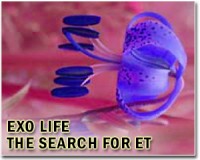 |
Washington Dec 2, 2010 Bacteria that thrive on arsenic have been scooped from the depths of a California lake, a discovery that redefines the building blocks of life and offers new hope in the search for extraterrestrial beings. Not only do the bacteria survive on arsenic, they also grow by incorporating the element into their DNA and cell membranes, said the study funded by the US space agency NASA and published Thursday in the journal Science. The findings add a new dimension to what biologists consider the necessary elements for life, currently viewed as carbon, hydrogen, nitrogen, oxygen, phosphorus and sulfur. "What is new here is arsenic is being used as a building block for the organism," explained Ariel Anbar, co-author of the study. "We have had this idea that life requires these six elements with no exceptions and here it turns out, well maybe there is an exception." The discovery was made by Felisa Wolfe-Simon, a former postdoctoral scientist in Anbar's research group at Arizona State University's School of Earth and Space Exploration. "If something here on Earth can do something so unexpected, what else can life do that we haven't seen yet? Now is the time to find out," she said. NASA's vague announcement earlier this week of a press conference on "an astrobiology finding that will impact the search for evidence of extraterrestrial life" set the Internet abuzz with speculation. Astrobiology relates to the study of life in the universe, including its origin and evolution, where it is located and how it might survive in the future. But Anbar acknowledged while the discovery is exciting in that it shifts the notion of what is needed for life to exist, it would be quite a leap to presume the next step is discovering alien life on other planets. "It is more the principle of the thing," he said. "We are very influenced by life as we know it and it gets very difficult to know, how far can we push that? How different can life be and still work?" A few years ago, Wolfe-Simon, Anbar and colleague Paul Davies began discussing the idea that different life forms could exist on Earth but by biological rules unlike ours, a notion known informally by scientists as "weird life." The trio published their 2009 hypothesis that arsenic, which is directly below phosphorus on the periodic table, could substitute for phosphorus in Earth life forms. "We not only hypothesized that biochemical systems analogous to those known today could utilize arsenate in the equivalent biological role as phosphate," said Wolfe-Simon. "But also that such organisms could have evolved on the ancient Earth and might persist in unusual environments today." Wolfe-Simon then went out into the field to test the theory, collaborating with Ronald Oremland, known as a world expert in arsenic microbiology, of the US Geological Survey. She scooped sediment from Mono Lake, known for its high levels of salt and arsenic, in eastern California and brought the material back to the lab. "She takes this sediment, puts it in a bottle essentially where there is lots of arsenic and very little phosphorus, and she does it over and over so only organisms that are going to be happy in that environment survive," said Anbar. Wolfe-Simon was able to get a bacteria known as strain GFAJ-1 of the Halomonadaceae family of Gamoproteobacteria to grow in the lab. "The organism came from nature," said Anbar. "It is a known bacteria. It is not a brand new bug but nobody realized it could do this." The discovery could open new avenues in disease research, and possibly new chapters in biology books, researchers said. Previous scientific discoveries have found examples of life forms existing on Earth in extreme heat, cold, acidic environments and airless underground pockets. "Sometimes you think something is not going to work, but then you go looking for it and sometimes you may find it," said Anbar. "And then you realize, oh, I didn't understand things quite as well as I thought I did before. And that happens all the time in science. That's part of what makes it fun."
Share This Article With Planet Earth
Related Links Life Beyond Earth Lands Beyond Beyond - extra solar planets - news and science
 NASA To Announce Astrobiology Finding: Major Impact On Search For Life
NASA To Announce Astrobiology Finding: Major Impact On Search For LifeMoffett Field CA (SPX) Nov 30, 2010 NASA will hold a news conference at 2 p.m. EST on Thursday, Dec. 2, to discuss an astrobiology finding that will impact the search for evidence of extraterrestrial life. Astrobiology is the study of the origin, evolution, distribution, and future of life in the universe. The news conference will be held at the NASA Headquarters auditorium at 300 E St. SW, in Washington. It will be broadcas ... read more |
|
| The content herein, unless otherwise known to be public domain, are Copyright 1995-2010 - SpaceDaily. AFP and UPI Wire Stories are copyright Agence France-Presse and United Press International. ESA Portal Reports are copyright European Space Agency. All NASA sourced material is public domain. Additional copyrights may apply in whole or part to other bona fide parties. Advertising does not imply endorsement,agreement or approval of any opinions, statements or information provided by SpaceDaily on any Web page published or hosted by SpaceDaily. Privacy Statement |